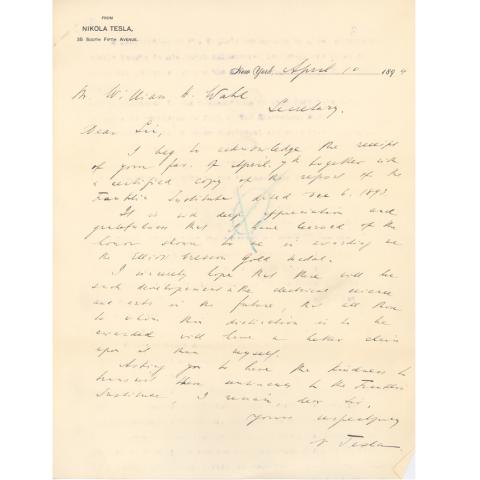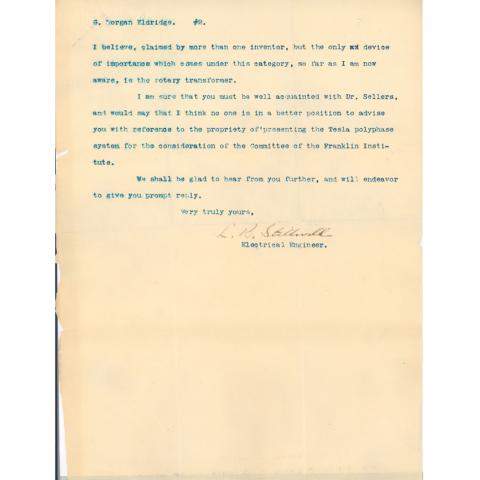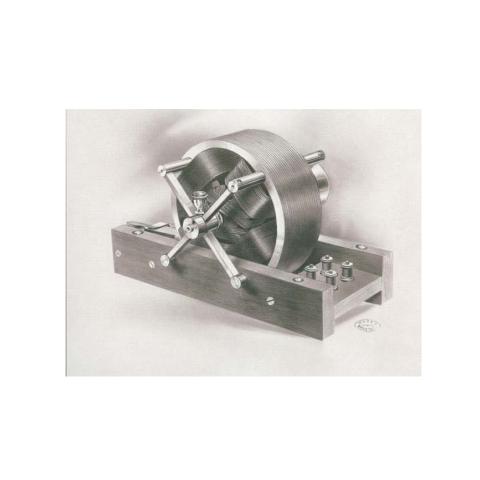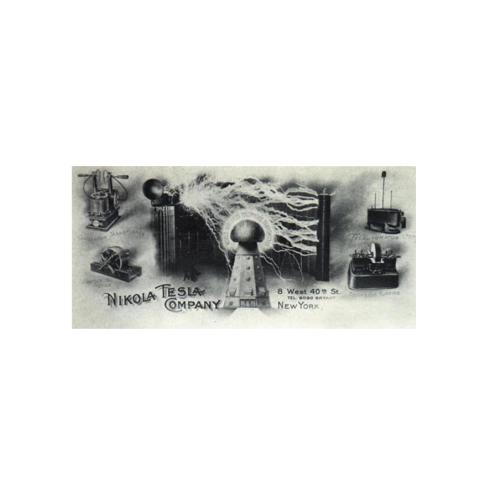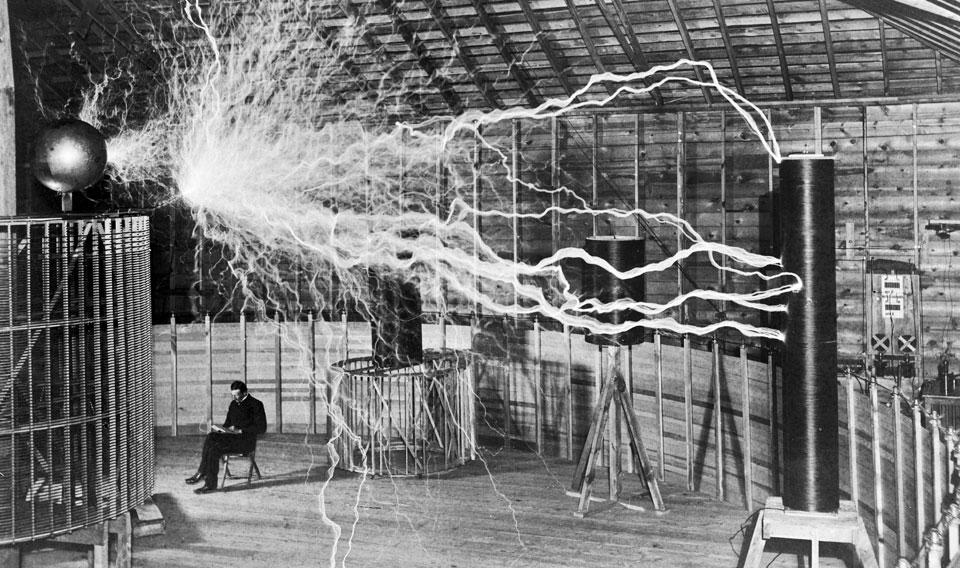
Introduction
Born in a rural village in Croatia, Nikola Tesla would bring his brilliant scientific mind to America in 1884 to work with Thomas Edison. It was George Westinghouse, however, who fully recognized Tesla's brilliance and initiated a partnership with him. During that temporary partnership with Westinghouse and for many years that followed, Tesla generated amazing new advances in electrical engineering and earned patents by the dozen.
Who was Nikola Tesla? What were his contributions to research in high frequency phenomena?
Brilliant Imaginings
Nikola Tesla was born on July 9, 1856, in Smiljan, a village in rural Croatia, then part of the Austro-Hungarian empire. He was the son of a Serbian Orthodox priest who was a notable preacher, and a clever and inventive, though uneducated, mother. Tesla was the second son in a family of two boys and three girls. His brilliant 12-year-old brother, Dane, died from an accident when Nikola was five years old.
Tesla grew up a keenly imaginative child, becoming fluent in six languages and developing a fascination for mechanical contraptions. A science prodigy, he was destined for the family occupations of priesthood or the military, but he was able, during a childhood illness, to get permission to pursue his dreams in science. He described his adventurous imaginings to be much more than dreams; instead, they were highly detailed visualizations with a dash of intuition added.
Between the age of 10 and 14, Tesla attended school in the town of Gospic, graduating as a brilliant student who had taught himself as much outside the classroom as he had learned inside. During the next three years at college in Carlstadt, Tesla discovered his lifetime passion: the science of electricity. His announcement of this choice was resisted by his parents, but decisions delayed when Tesla succumbed to the cholera epidemic in his hometown. He was dangerously ill and restricted for a year, and when he recovered, his father permitted his son's engineering ambitions to go forward.
Planting Seeds
In 1875, Tesla began studying electrical engineering at the Polytechnic Institute in Graz, Austria. Again, with obsessive effort that permitted only study, he excelled. In Graz, Tesla was able to observe the new Gramme machine, which generated direct current electricity using electromagnets and could also be reversed to operate as an electricity-driven motor. The demonstration planted an intuitive seed in Tesla's brain. Why was it necessary to go to such lengths to convert the alternating current (AC) produced by the dynamo to direct current (DC)? Why not leave the current AC and run the motor that way?
The electrical standard at that time was DC, the same mode produced by a battery, the mode that everyone was used to and accepted. To even imagine usable alternating current was visionary. Tesla's strong instincts told him this was possible, but at that time, in spite of his visualization efforts and the mental gymnastics of picturing many operating dynamo models, he failed to find the solution to this nagging problem.
Breakdown and Revelation
Tesla moved on to study electricity at the University of Prague and, short of funds, left after a year for a minor position with the newly-established Hungarian Telegraph Office in Budapest. Recognition of his ability came quickly and, in 1881, he was made manager of the telephone company and, with his characteristic enthusiasm, worked, invented, and began his avalanche of discoveries. However, his fixation with the alternating motor idea remained and eventually manifested in a critical mental and physical breakdown with highly mysterious symptoms. A hypersensitivity to sounds, light, and vibration brought shivers, twitches, and wildly erratic pulse rates. The illness continued for some months and defied medical diagnosis. Physical improvement came, the extreme sensitivity subsided, and Tesla returned to work still maintaining his captivation with the AC motor puzzle.
The puzzle's solution came to him in dramatic fashion in February, 1882. While walking with a friend at sunset, reciting poetry by Goethe, a spasm of revelation struck Tesla. He stood transfixed, explaining how an AC motor would work. The vision he outlined in minute detail had surfaced spontaneously in response to the questions he had asked himself back in 1875. Tesla later described his visualization powers with the example that he would envisage a design in meticulous detail, then return to the retained image days or weeks later and be able to examine it for wear as if it had been running during the intervening period.
In the midst of this excitement, Tesla's employer sold the telephone company but encouraged this unusual genius to move to Paris for work and expanded opportunities. Tesla moved to Paris in April of 1882.
Interested in learning more about Nikola Tesla? Learn More About His Cresson Award
Dreams to Reality
In Paris, Tesla was referred to a junior engineer position with the Compagnie Continental Edison, the branch of the American company set up to expand Edison’s DC generators and lighting systems. Advancing quickly, Tesla became one of the traveling repairmen sent to work on installations throughout Europe. He continued to be a strange, phobic character and talk enthusiastically about his AC system. He received little attention from colleagues who were too busy expanding the DC system. The company had stunned the public by illuminating the 1881 Paris Electrical Exhibition and was setting up generators to light-restricted areas such as factories. However, the one-mile transmission range for practical DC transmission limited sales to larger installations such as towns and cities.
The German city of Strasburg did purchase an Edison system, but the dedication ceremony for the railroad station lighting was disastrous. Throwing the switch caused an immediate explosion which blew out a wall of the train shed. The German-speaking Tesla was dispatched to deal with the problem. He spent a year doing the repairs and waiting for various levels of bureaucracy to approve the work.
During the slow time of waiting, Tesla was able to convert his dreams to reality. In a rented machine shop, he built the solid version of the dynamo he had preserved in his mind's eye during the previous year. The model worked beautifully. On returning to Paris, Tesla's plan was to collect his Strasburg bonus for start-up funds and find French financial backers as he built his new AC generators and motors.
The bonus did not materialize, either through lack of funds on the Edison company's part or misplaced expectations on Tesla's part. Edison managers advised Tesla to take his dreams and plans and try them out in America. The 28-year-old who had studied, worked, and traveled through much of central Europe set out for the United States.
Coming to America
Nikola Tesla arrived in New York on June 6, 1884, and set out to look for the friend he would live with. He stopped to do an engine repair job he happened to find along the way, and met with Thomas Edison, a meeting he described as "a memorable event in my life."
Working for Edison, Tesla again advanced quickly and his many patentable designs improved efficiency and controls. Tesla again became convinced that Edison had not lived up to a promise of bonuses and he resigned from the company within a year.
By this time, Tesla's engineering reputation was known and he found financial backing to develop his cherished AC generators and motors. The Tesla Light and Manufacturing Company was established and began to produce AC-driven arc lighting. Following completion of the project that illuminated the city of Rahway, New Jersey, Tesla expected to go on to manufacture his generators but his naivety brought failure. In the fall of 1886, the backers disagreed with Tesla, tricked him out of his money and patents, and left him penniless.
In the next step of his eventful life, Tesla spent the winter of 1886 working as a ditch digger and no doubt telling everyone he met of his AC electricity systems. A foreman recognized his promising labor and introduced Tesla to superiors who also appreciated his possibilities.
Recognized Genius
In April of 1887, the Tesla Electric Company was born in southern Manhattan and Tesla finally had the opportunity to build—in reality—the entire electrical systems, from generators through transformers to motors, that had been in his visual memory since that day in Budapest.
When he applied for the patent on his invention, he was directed by the patent office to rework and resubmit it broken into seven separate sections to reflect the inventive scope of the work. U.S. patents numbered 381,968 through 381,970 and 382,279 through 382,282 were issued on May 1, 1888.
The engineering fraternity began to notice Tesla and he was persuaded to address the American Institute of Electrical Engineers on May 16, 1888. Tesla's description of the theory and realization of his inventions was greeted as a masterwork; his genius was recognized.
Partnerships
Tesla had very little interest in the commercial development of his inventions, preferring to continue his "dreaming" and trust that somehow funding would materialize. Opportunity came in the form of George Westinghouse, an inventor and businessman from Pittsburgh who had made his fortune manufacturing air brakes for the burgeoning railroad industry. Westinghouse saw Tesla's potential and Tesla accepted his offer of one million dollars for his patents plus a royalty of one dollar per horsepower on all motors produced. Tesla now had enormous riches to match his reputation and his genius.
The arrangement required that Tesla spend time at the Pittsburgh plant as production of his motors started up. He did not enjoy the inevitable conflicts that arose in converting theoretical and pilot plant design to full scale production and gladly returned to New York at the end of the year. Manufacture of the motors began soon afterwards and Tesla happily went back to his laboratory. During the next four years, he received 45 U.S. patents.
At this time, the major application for electricity was in lighting from the DC incandescent lamps developed by Thomas Edison and the AC arc lights supplied by Westinghouse and the Thomson-Houston Company. The United States financial climate in this era of industrial expansion was dominated by the demand for capital and consolidations were common. Thomson-Houston merged with Edison and others to become the General Electric Company and Westinghouse needed partners to ensure its solvency.
These potential partners demanded that Westinghouse cancel his royalty arrangement with Tesla, a step this fellow inventor was reluctant to take. With no other choice, Westinghouse approached Tesla to cancel their contract with its multimillion-dollar value while stressing his commitment to AC power and Tesla's efforts. Citing his friend's confidence and support, Tesla simply tore up the contract. This hugely generous gesture meant that the Westinghouse Electric and Manufacturing Company flourished. By definition, Tesla had also shrunk the funding for his own further research and inventions by at least ten million dollars.
Electrical Endeavors
Now 33 years old, a rich man who had rejected marriage in favor of his devotion to science and nature, Tesla applied his genius to wider, greater endeavors. He set out to investigate the limits of electromagnetic radiation. He created an electric current operating at up to 10,000 cycles per second (the U.S. standard is 60) in an effort to duplicate a light beam. He noted the advantage of high frequency current in the transformer used for electricity transmission and went on to invent the Tesla coil transformers in insulating oil baths still in use today. Tesla's experiments reached a frequency of 20,000 cycles per second at extremely high voltages. At an address to the American Institute of Electrical Engineers in May, 1891, he caused a sensation by demonstrating 100,000 volt spark discharges five inches long, plus the brightest of electric lamps, from transformed alternating current.
Tesla was now a public hero, celebrated everywhere, yet still obsessed with his appetite for knowledge of all things electrical. He returned the favor of many invitations with elaborate meals for his guests followed by a laboratory show of all kinds of spellbinding, glowing, sparking, and spinning objects driven by electricity. The highlight was a demonstration in which he passed electric current through his body from head to toe, having first determined the optimum frequency and power, then producing these conditions using his high-frequency dynamos and coil transformers.
Eventually accepting European invitations, Tesla took his enlightening lecture and show of amazing electrical experiments on the road. In just eight years since leaving Paris for the United States, Tesla had gone from penniless immigrant to engineer to destitute ditch digger to international celebrity—all by the age of 36. Among the innovative, and later widely adopted, inventions he demonstrated were neon and phosphorescent lamps, electronic tubes for wireless signal reception, and coil tuning principles used in radios.
A War Won
While in Paris, Tesla learned of his mother's serious illness and left for Gospic; he was able to be with her during her final weeks of life. He was treated as a national hero while in his homeland. A severe illness he suffered while in Serbia prompted Tesla to self-examination and a resolution to avoid all further distractions and concentrate on his experimentation. He returned to New York, resumed his solitary lifestyle, and restarted his investigations of electricity's promise.
In May, 1893, The Columbian Exhibition opened in Chicago with illumination inside and out supplied by the Westinghouse Company using Tesla technologies. The Westinghouse installation was "outshining" Edison's lighting efforts and Tesla supplied a spectacular personal rebuttal to Edison's claim that AC current was by nature too dangerous for everyday use.
Since Tesla's first introduction of AC electricity, the "War of Electric Currents" had been waged, with Edison insisting on the safety of DC current over AC current. The safeness in fact came from the minimal strength of the direct current.
Now Tesla disproved that claim by letting a charge of one million volts be passed through his body without harm. Alternating current had won the "War."
Westinghouse also used the Tesla polyphase system in harnessing the power of Niagara Falls to produce 37,300 kilowatts electrical output from ten generators and transmit it to Buffalo, which was 22 miles away. The system went online in August, 1895.
Front Page News
To advance his experiments with high frequency, Tesla built a reciprocating engine, operable by air or steam, which led to an altercation with the Police Department. From watching the machine's vibrations, he was side-tracked into investigating the mechanical vibrations it caused. He came to believe that mechanical vibrational resonance was similar to the resonances of electric current. The "high-vibrations" machine he built worked too well. It operated strongly enough to raise neighborhood fears of an earthquake and caused the police shutdown of his experiments.
In September, 1898, Tesla was again front page news with his demonstration of a remotely-controlled robotic boat. The model boat was wirelessly controlled by the signals from Tesla's transmitter to its antenna and receiver and then to a servomechanism which translated the signal to a variety of maneuvers: starting, stopping, turning, etc. This was a remarkable combination of wireless telegraphy and robotics.
Tesla, an American citizen since 1889, offered this invention to the U.S. government but it was ridiculed and rejected. A patent was granted in November, 1898, but only after the Chief Examiner had visited New York to confirm the machine was really operable.
Next, Tesla returned to his experiments with power sources but having built an oscillator that produced 4 million volts, he had reached his laboratory's safety limitations and was short of money yet again.
An offer of much space and operating funds sent Tesla to Colorado Springs in May, 1899. The Tesla coil transformers in Colorado were huge, 75 feet in diameter and produced correspondingly large voltages and frequencies—artificial lightning bolts 135 feet long and accompanying thunder heard 15 miles away. Tesla had charged the earth to a level that would only have been achievable by hundreds of natural lightning bolts. Enough power was used to overload and cause short circuits at the powerhouse of the Colorado Springs Electric Company. Again Tesla's experiments were curtailed and he returned to New York to report on his findings. Further details of the Colorado experiments remained locked in Tesla's imagination until he died.
Advancing Humanity
Out of money again, Tesla returned to New York in the fall of 1899, satisfied that he had advanced his overriding and glorious goal of improving the condition of humanity by extending scientific knowledge. Through a friend, he published an article entitled "The Problem of Increasing Human Energy" which outlined his personal philosophy and his Colorado discoveries. Tesla believed that the type of energy available had been and would continue to be the controlling factor in the progress of the human condition, reducing such developments to a mechanical process. Thus, by discovering and improving electrical energy, he was playing his part in advancing humanity: a grandiose assertion.
J. Pierpont Morgan was Tesla's next benefactor. He had underwritten the Niagara Falls power system and was aware of Tesla's genius and now supported his ideas on transmitting electric power through the earth and on worldwide wireless broadcasting. Morgan could imagine the commercial potential, which never occurred to Tesla, and the importance of controlling the release of the ideas' conclusions. Tesla now had a willing supporter and spoke of Morgan's "noble generosity."
Again, in 1900, Tesla set out to build a new plant in Long Island, New York, intended as a source of a universal power supply and world-wide broadcasting. The enormous scope of his project never troubled Tesla; with Morgan's first donation, he confidently went forward. Stanford White agreed to design the centerpiece building of this new industrial city, a 154-foot-high tower to be the origin of the electrical power. Inevitably, delays crept into the project and bills went unpaid. The project ceased in 1905 and Tesla returned to New York City.
Pure vs. Applied Science
Tesla refused further lucrative offers which did not meet his idealistic purposes and took the consequences. He returned to the design of turbines and by 1910 had models available. However, his entry competed with machinery which had been developed in the interval since Niagara when Tesla was occupied with his Colorado and Long Island enterprises. Tesla's secretive nature and stubbornness caused problems and he met an audience which was not inclined to cooperate. The Tesla turbine, a machine of great ingenuity and promise, did not succeed.
In 1912, the Nobel Committee announced that Nikola Tesla and Thomas Edison were the recipients of the Physics Prize; instead, the prize went to Gustav Dalen. Details of the reversal are unclear but it is known that Tesla refused the prize (and the $20,000 that came with it). Tesla differentiated between inspirational discoverers such as himself and methodical improvers such as Edison; he gave greater value to the former. Tesla was a pure scientist and Edison an applied scientist, and they should not be in combination. Tesla was persuaded to accept the 1917 Edison Medal from the American Institute of Electrical Engineers but made his disinterest noticeable.
Continued Progress
Tesla continued his work on power generation, making occasional announcements of progress which reached the press. He mentioned many discoveries but supplied no experimental details. He had enough money to live and always remained optimistic. There was talk of Tesla having invented a "death ray beam"; he spoke of sending a beam from Earth to the dark side of the moon. The discovery of atomic physics sent Tesla's mind racing to cosmic possibilities as he celebrated what he saw as the reach of man nearing that of “the Creator”. He described himself as "merely an automaton endowed with power of movement, responding to the stimuli of the sense organs and thinking and acting accordingly”.
His admiration for the human mind stood in contrast to his definition of the human body as "a meat machine which responds to external forces”.
Tesla died of heart failure, a forgotten man, on January 7, 1943, the Orthodox Christmas Day of that year. Agents from the Federal Bureau of Investigation immediately removed the papers from Tesla's safe, citing wartime security concerns. His funeral was conducted in New York, and his body was cremated.
Introduction (Science)
Michael Faraday first demonstrated the connection between magnetism and electricity by moving a magnet inside a coil of wire. So long as the magnet moved in relation to the coil, an electric current was induced in the wire; when the magnet was stationary, the current ceased. Faraday further suggested that the electromagnetic forces which occurred spread into the area around the wire. The first electricity generator, known as a dynamo, applied these principles with a cranked permanent magnet spinning inside a wire coil. Each time the magnet turned, a current in alternating directions was produced, depending on which pole of the magnet was passing the wire. All electric currents available at the time of this discovery were the direct currents from the batteries invented by Alessandro Volta, so this alternating current was altered to direct by adding a commutator (switch) to the dynamo design.
The Gramme dynamo, which so intrigued Tesla, improved on previous versions. It was made up of a series of thirty coils, connected in series with a commutator at each connection, placed inside a rotating, magnetized iron ring. It created an almost uninterrupted direct current with the drawback that Tesla noticed—sparking at the commutator brushes due to the tiny power disruptions. The dynamo was reversible; a supply of electricity to the coils induced rotation of the magnet, which could be connected to the spindle of a motor. Electrical force could be converted to mechanical force and vice versa.
Two-Phase Induction Motor
In the two-phase motor, two sets of coils are set perpendicular to each other surrounding the core. When alternating current is sent to the coils, they become electromagnets where polarity rapidly changes with each reversal of current flow. As the first coils are supplied with current, they create a magnetic field which starts the core turning. When the first coil’s current supply reverses, the second coil set is at its maximum supply point and creates its own magnetic field; the core spins on. In effect, the "magnetization" amount never varies and a rotating magnetic field is created. The result is a smooth-running, commutator-free motor with the rotor as its only moving part.
The Tesla Transformer
Tesla described his coil as "a simpler device for the production of electric oscillations" for use in the design of high frequency machines.
In this device, a primary transformer coil with a few turns of wire is connected to a selected condenser (or capacitor) through a spark gap. When the condenser is supplied with electric current, it continuously charges up to reach the point where it achieves the selected breakdown voltage of the gap, and a spark results. At the moment of sparking, the condenser and primary coil are connected and form an oscillating circuit.
As the charge-to-spark process is rapidly repeated, the high energy pulsation in the primary coil induces voltage in the secondary transformer coil, which has many turns of smaller wire. Settings and adjustments of each circuit control the oscillation frequencies of each circuit and optimum operation is achieved when the oscillating frequencies match, i.e. resonate. Then, the oscillation in the second coil is multiplied, the coil produces high voltage, and strong sparks are emitted by the secondary terminal. With this output voltage reaching many millions of volts, some exceptional lightning-like discharges can be created.
Credits
The Nikola Tesla presentation was made possible by support from The Barra Foundation and Unisys.
Read the Committee on Science and the Arts Report on “Nikola Tesla’s Researches in High Frequency Phenomena."


